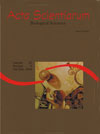<b>Fauna de parasitos metazoários de <em>Pimelodus maculatus</em> La Cépède, 1803 (Siluriformes, Pimelodidae) do rio Guandu, Estado do Rio de Janeiro, Brasil</b> - DOI: 10.4025/actascibiolsci.v29i1.130
Resumo
Sessenta espéimes de Pimelodus maculatus provenientes do rio Guandu, Estado do Rio de janeiro, foram examinados para estudo de sua parasitofauna, no perído de agosto de 1999 a fevereiro de 2001. Foram coletados espéimes de doze espécies de parasitos metazoários alocados em sete grupos taxonômicos - Monogenoidea: Demidospermus uncusvalidus Gutiérez and Suriano, 1992, D. paravalenciennesi Gutiérez and Suriano, 1992, D. majusculus Kritsky and Gutiérez, 1998 e Scleroductus sp.; Digenea: Austrodiplostomum compactum (Lutz, 1928); Eucestoda: Nomimoscolex sp.; Nematoda: Cucullanus pinnai Travassos, Artigas and Pereira, 1928 e Procamallanus sp. (jovem); Hirudinea: Helobdella sp.; Myxozoa: Henneguya sp. e Myxobolus absonus Cellere, Cordeiro e Adriano, 2002, al駑 de uma esp馗ie de Acanthocephala (cistacanto) não identificada. Houve correlação entre o sexo do hospedeiro com a preval麩cia e com a abundâcia de D. paravalenciennesi. A espéie mais dominante na comunidade parasitáia de P. maculatus do rio Guandu foi D. uncusvalidus (50%), seguida de C. pinnai (18,3%). Demidospermus majusculus e Henneguya sp. constituem primeiro registro em P. maculatus. Demidospermus uncusvalidus, D. paravalenciennesi, D. majusculus, Scleroductus sp., Nomimoscolex sp., C. pinnai, Procamallanus sp., Helobdella sp., Henneguya sp. e M. absonus apresentam ampliada sua distribui鈬o geogr畴ica conhecida.Downloads
DECLARAÇÃO DE ORIGINALIDADE E DIREITOS AUTORAIS
Declaro que o presente artigo é original, não tendo sido submetido à publicação em qualquer outro periódico nacional ou internacional, quer seja em parte ou em sua totalidade.
Os direitos autorais pertencem exclusivamente aos autores. Os direitos de licenciamento utilizados pelo periódico é a licença Creative Commons Attribution 4.0 (CC BY 4.0): são permitidos o compartilhamento (cópia e distribuição do material em qualqer meio ou formato) e adaptação (remix, transformação e criação de material a partir do conteúdo assim licenciado para quaisquer fins, inclusive comerciais.
Recomenda-se a leitura desse link para maiores informações sobre o tema: fornecimento de créditos e referências de forma correta, entre outros detalhes cruciais para uso adequado do material licenciado.












1.png)




3.png)













